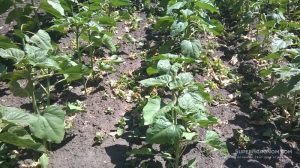Sunflower development phases and crop care

03.04.2025
Sunflower Remains a Highly Profitable Crop in Ukraine
Sunflower continues to be one of the most profitable crops for cultivation in Ukraine. In 2024, its profitability reached 106%, yielding a net profit of approximately 40,000 UAH per hectare. This success is attributed to high grain prices and consistent demand from processors.
Projected Increase in Sown Areas
For 2025, forecasts indicate that the area sown with sunflower will remain stable at up to 5.5 million hectares. According to First Deputy Agriculture Minister Taras Vysotskiy, the sown area is expected to be consistent with previous years, reflecting the sustained interest of Ukrainian farmers in this crop.
Key Factors for Successful Cultivation
To achieve high yields and profitability, it is essential to consider the following aspects:
- Seeding Depth: It is recommended to sow sunflower seeds at a depth of 3 to 5 cm, depending on soil type—shallower depths for heavier soils and deeper for lighter soils—to promote uniform field emergence and plant stand.
- Uniformity of Sowing: Ensuring consistent seeding depth and spacing is crucial for synchronized germination and uniform plant development.
- Field Monitoring: Regular inspections of plant health and developmental stages enable the timely identification and resolution of potential issues.
- Consideration of External Factors: Weather conditions, pests, and diseases can significantly impact sunflower growth. Prompt responses and appropriate protective measures are necessary to mitigate
Sunflower Growth Stages
Sunflower development is divided into several key phases:
- Emergence (BBCH 09): Cotyledons appear above the soil surface.
- Leaf Development (BBCH 10-19): Formation of the first and subsequent pairs of true leaves.
- Inflorescence Emergence (BBCH 51-59): Beginning of flower head development.
- Flowering (BBCH 60-69): Opening of flowers and pollination.
- Ripening (BBCH 80-89): Seeds mature to full ripeness.
Crop Management Practices
- Weed Control: Sunflower grows slowly from emergence to the 2-3 leaf pair stage, making it susceptible to weed competition. Pre-emergence herbicide application can provide six to eight weeks of residual weed control for various weed species.
- Fertilization: Sunflowers require substantial nutrients. The fertilization program includes:
- Applying nitrogen, phosphorus, and potassium fertilizers based on soil tests to meet the crop’s nutritional needs.
- Irrigation: Although sunflowers are drought-tolerant, critical periods for water supply include the bud stage, flowering, and grain formation stages. Adequate irrigation during these times is essential for optimal development.
- Pest and Disease Management: During the flowering stage, it is important to monitor for pests and conduct fungicidal treatments against diseases such as Sclerotinia, Phomopsis, Phoma, and Alternaria.

Conclusion
Understanding sunflower development stages and timely crop management are key factors for achieving high yields and seed quality in Ukraine. Sunflower remains one of the most profitable crops in the country. The projected stable sown area in 2025 reflects the continued interest of farmers in this crop. Adhering to cultivation technology recommendations and conducting continuous field monitoring will contribute to high yields and maximize profit.
